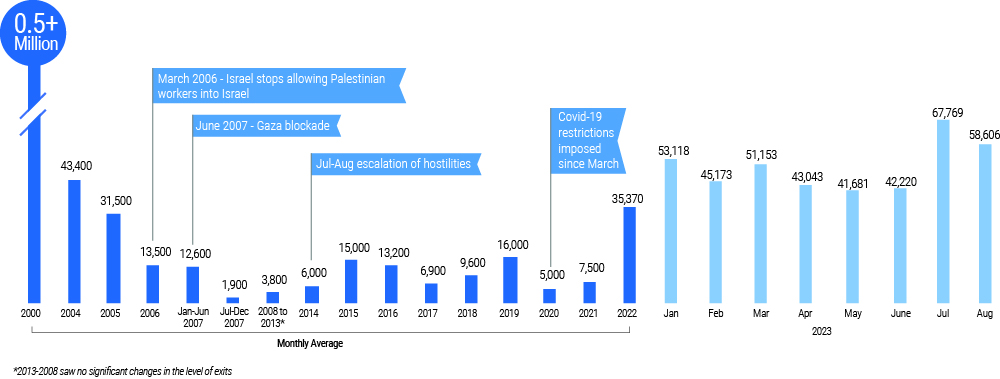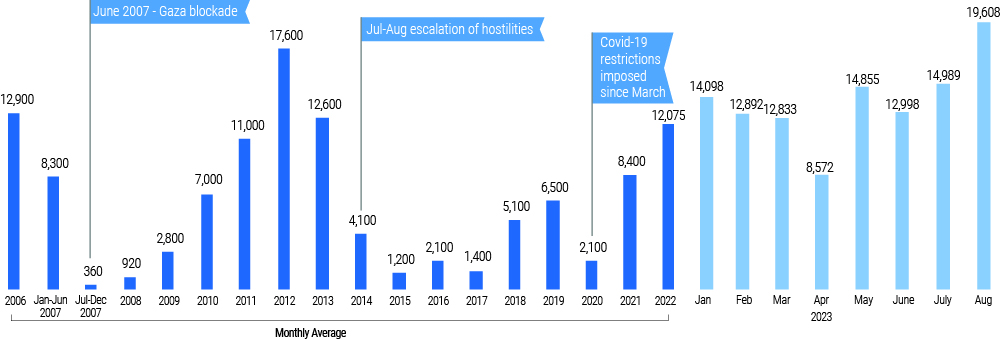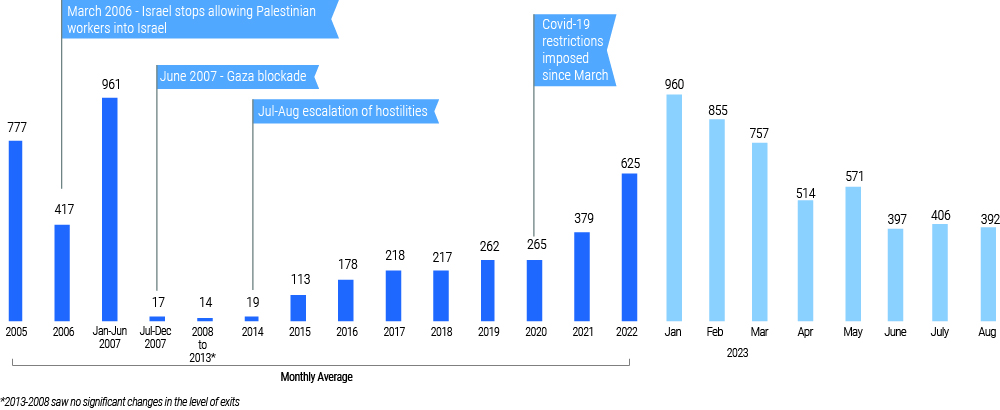Movement in and out of Gaza: update covering August 2023
Highlights
- August 2023 recorded fewer exists of people from Gaza compared with July. While the Egyptian border admitted the highest number of exits since July 2012, fewer exists were recorded through the Israeli passenger crossing.
- The volume of incoming goods surpassed pre-blockade levels. Yet, the increase fails to account for population growth and rising needs, and outgoing commodities remained at levels similar to those recorded in previous months.
Background: Longstanding restrictions on the movement of people and goods to and from Gaza have undermined the living conditions of its over two million Palestinian residents. Many of the current restrictions, originally imposed by the Israeli authorities in the early 1990s, were intensified after June 2007, following the Hamas takeover of Gaza, when the Israeli authorities imposed a blockade. Despite some easing of import restrictions since 2021, the remaining limitations continue to hinder access to livelihoods, essential services, and housing, disrupting family life and undermining people’s hopes for a secure and prosperous future. The situation has been compounded by the restrictions imposed by the Egyptian authorities at Rafah crossing.
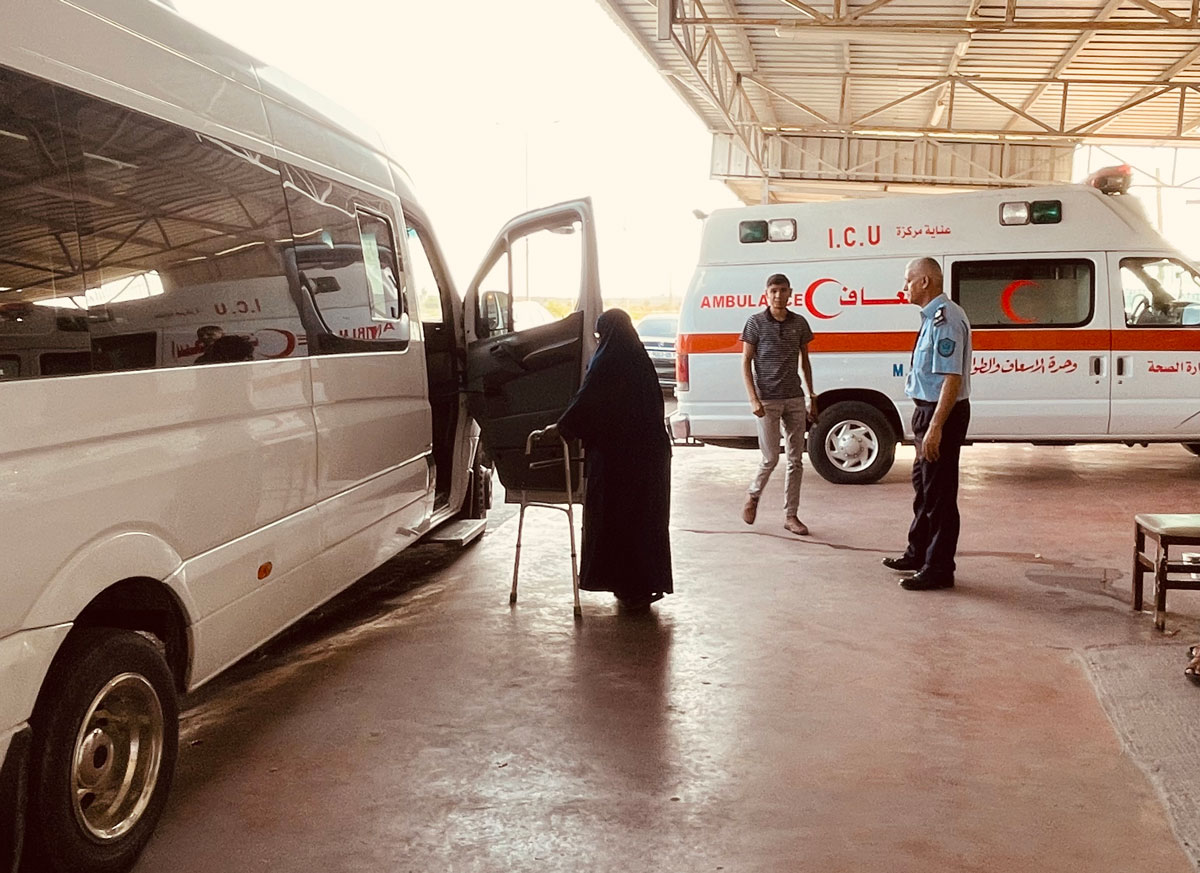
Palestinians at the Israeli-controlled Erez crossing on their way out of the Gaza Strip for medical treatment. Photo by OCHA, 23 August 2023
Movement of people to Israel and the West Bank
- In August, the Israeli authorities allowed 58,606 exits of people from Gaza. This represents a 14 per cent decrease from July and is 65 per cent above the monthly average in 2022. However, the number of exits were 88 per cent below the monthly average in 2000, before the imposition of category-based restrictions by the Israeli authorities.
- Some 87 per cent of the exits were of Palestinians allowed to leave for work-related purposes, primarily as day labourers in Israel.
- Six per cent of the exits were by patients referred for medical treatment in the West Bank or Israel. A total of 1,899 exit permit applications were submitted to the Israeli authorities for medical appointments scheduled for August. Of these applications, 19 per cent were not approved on time, compared with 19 per cent in July. Click here for more information.
Palestinians are banned from exiting Gaza via Israel, including for passage to the West Bank, unless they obtain an Israeli-issued exit permit. Only those belonging to certain categories, primarily day labourers, traders, patients and their accompaniers, and aid workers, may apply for such permits. Other people are not eligible for a permit even if according to the Israeli authorities they do not pose a security risk. In many cases, the Israeli authorities do not provide specific reasons for the rejection of an application. If an application is approved, the permit holder may travel through the Israeli-controlled Erez crossing, which operates during the daytime, from Sunday to Thursday, and on Fridays for urgent cases and foreign nationals only.
Movement of people to Egypt
- In August, the Egyptian authorities allowed 19,608 exits of people from Gaza. This figure represents the highest number of exits recorded since July 2012. Furthermore, it was 31 per cent higher than the number of exits in July, and 62 per cent higher than the monthly average recorded in 2022. The increase can be attributed to people who left Gaza following a visit during the summer.
- In August, the Egyptian authorities denied the entry of 314 people, an increase from the 216 denials reported in the previous month. The grounds for denial are typically not provided. Still, according to local Palestinian authorities, Egyptian authorities have often cited security concerns or imposed specific limits, particularly affecting men aged 18 to 40.
Background: Palestinians wishing to exit Gaza via Egypt must register with the local Palestinian authorities two to four weeks in advance. People may also apply to the Egyptian authorities, using the services of a private company. The procedures and decisions by both authorities lack transparency. Approved passengers exit through the Rafah Crossing, which is controlled and operated by the Egyptian authorities from Sundays to Thursdays. The journey through the Sinai desert is often lengthy and includes multiple stops for checks by Egyptian forces.
Incoming goods
General goods (excluding fuel and gas)
- In August, 12,076 truckloads of authorized goods entered Gaza through the Israeli and Egyptian-controlled crossings. This is 18 per cent more than the volume of goods entering in July, 36 per cent more than the monthly average in 2022, and 8 per cent more than the monthly average just before the blockade in 2007. However, Gaza's population has grown by 60 per cent since 2007, and so have their needs.
- Among the goods that entered Gaza, 42 per cent were construction materials, and 22 per cent were food supplies. About 3 per cent were humanitarian aid items facilitated by international organizations, primarily food and medical supplies.
- About 63 per cent of the goods entered via Israel. This volume is 7 per cent higher than in July and nearly 23 per cent higher than the monthly average in 2022. Of these goods, about 32 per cent were construction materials, primarily aggregates, cement, and steel bars – a 28 per cent increase compared with the monthly average in 2022.
- The remaining 37 per cent of the goods entered Gaza via the Egyptian border, which opened for the movement of goods for 14 days. This volume is 43 per cent higher than that recorded in July and 66 per cent higher than the monthly average in 2022.
- Of the goods entering Gaza through Egypt, over 58 per cent were construction materials, consisting mainly of aggregates, cement, and steel bars. Most of the remaining goods were food.
Background: Since the imposition of the blockade in 2007, the Israeli authorities have restricted the entry into Gaza of goods they consider having a dual (civilian and military) use, such as building materials, certain medical equipment, and some agricultural items. Some of these goods may be allowed entry, following a lengthy application and review process. The entry of most of the goods from or via Israel (including non-restricted goods) is only possible via the Kerem Shalom crossing, following prior coordination with the Israeli authorities. Since 2018, goods have also entered Gaza regularly from Egypt, via the Rafah crossing, controlled by the Egyptian authorities, and then through the adjacent Salah Ad Din Gate, controlled by the local authorities.
Monthly average of incoming goods to Gaza (truckloads)
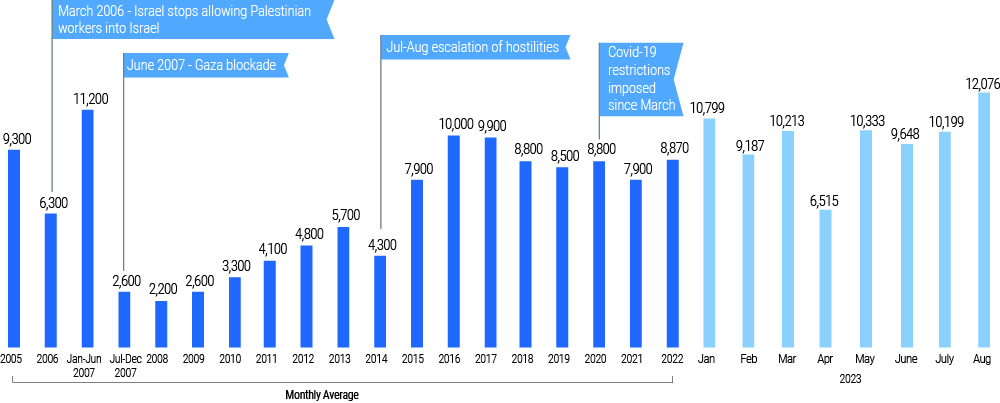
Fuel and gas
- In August, the volume of petrol and diesel entering Gaza from both Israel and Egypt slightly decreased compared with July. However, it remained 25 per cent higher than the monthly average in 2022. No restrictions are imposed on fuel imports, which are limited due by funding and storage capacity.
- The volume of incoming cooking gas in August increased by 9 per cent compared with July. It was 9 per cent higher than the monthly average in 2022.
- The volume of industrial diesel entering Gaza for the Gaza Power Plant (GPP) rose by 29 per cent compared with July. This surge is attributed to the activation of the GPP’s fourth turbine, which required additional fuel. This volume was 38 per cent higher than the monthly average in 2022.
Outgoing goods
- In August, 392 truckloads of authorized goods exited Gaza through the Israeli and Egyptian crossings. This represents a 3 per cent decrease compared with July and is 59 per cent lower than the monthly average in 2022.
- Of these truckloads, 234 exited through the Israeli border. This was 14 per cent below the volume of exits in July, and 76 per cent lower than the monthly average just before the imposition of the blockade in 2007.
- About 49 per cent of the goods that exited Gaza were destined for the West Bank, while the remaining 51 per cent were exported to Israel. The exiting goods included vegetables (40 per cent), textiles (23 per cent), fish (10 per cent), and other items, including furniture, scrap copper, and aluminum, among others constituting the remaining 27 per cent.
- An additional 158 truckloads were exported to Egypt, carrying scrap iron and used batteries. This marked a 24 per cent increase compared with the volume recorded in July. In both 2022 and 2023, the Egyptian authorities have permitted the exit of specific items including, used batteries, scrap iron, aluminum, and copper.
Background: Most products traded outside of Gaza are transported to markets via the Israeli-controlled Kerem Shalom crossing, where various restrictions apply. The exit of goods to the West Bank and Israel, Gaza’s main markets, was banned between 2007 and 2014, and then gradually reinstated. Since August 2021, certain goods have been exported to Egypt, via the Salah Ad Din gate and Rafah crossing.
Data source: Ministry of National Economy in Gaza. More data: ochaopt.org/data/crossings
